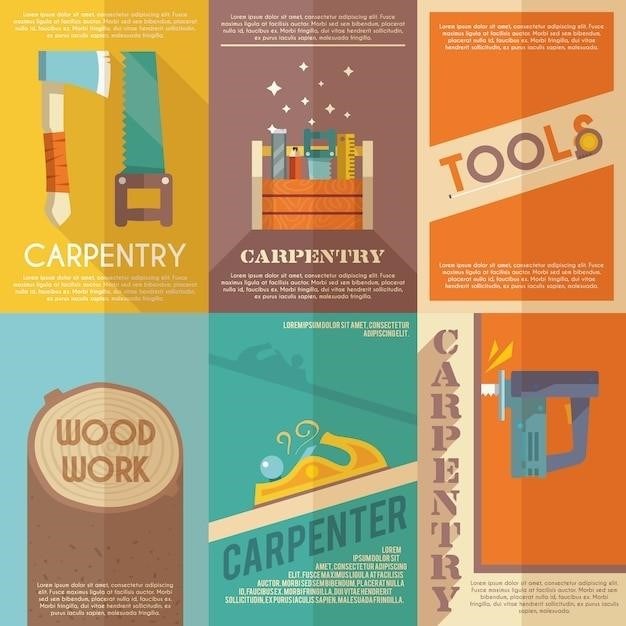Bosch RA1181 Benchtop Router Table⁚ A Comprehensive Guide
This guide provides a complete overview of the Bosch RA1181 benchtop router table. Learn about its key features‚ setup‚ safe operation‚ basic and advanced techniques‚ maintenance‚ troubleshooting‚ and where to find parts and manuals. Master this versatile woodworking tool!
Introduction to the Bosch RA1181
The Bosch RA1181 benchtop router table is a popular choice for both hobbyists and professionals seeking a versatile and robust woodworking tool. Its substantial 27″ x 18″ aluminum top provides a large‚ stable work surface ideal for various routing tasks. The robust construction ensures durability and longevity‚ while the portability of the design makes it suitable for workshops of any size. Designed for compatibility with a wide range of routers‚ the RA1181 offers adaptability and flexibility. Key features include a precision-engineered fence system for accurate cuts‚ integrated dust collection capabilities for a cleaner workspace‚ and a user-friendly design that simplifies setup and operation. This manual will guide you through the safe and efficient use of your Bosch RA1181‚ maximizing its potential for your woodworking projects. Whether you’re creating intricate profiles‚ performing precise edge work‚ or tackling more demanding tasks‚ the RA1181 is designed to deliver consistent‚ high-quality results. Understanding this manual is crucial for safe and effective operation. The Bosch RA1181 is more than just a router table; it’s a precision instrument designed to enhance your woodworking experience and capabilities.

Key Features and Specifications
The Bosch RA1181 boasts a large 27″ x 18″ aluminum top‚ providing ample workspace for various routing projects. This substantial work surface is complemented by a durable aluminum fence system‚ ensuring accurate and repeatable cuts. The table’s design incorporates a convenient 2-1/2″ vacuum hose port‚ facilitating efficient dust collection and maintaining a clean working environment. Precision is further enhanced by the inclusion of an aluminum mounting plate‚ ensuring secure and stable router installation. For added versatility‚ the RA1181 is compatible with a wide range of routers‚ adapting to various needs and preferences. Its robust construction ensures stability and durability‚ making it suitable for both occasional use and heavy-duty woodworking tasks. The table’s design prioritizes ease of use‚ allowing for quick setup and adjustment. Detailed specifications‚ including weight‚ dimensions‚ and compatibility details for specific router models‚ can be found in the comprehensive user manual accompanying the product. These features combined make the Bosch RA1181 a high-performance‚ user-friendly router table suitable for woodworking enthusiasts of all skill levels.

Setting Up Your Bosch RA1181
Begin by carefully unpacking your Bosch RA1181‚ ensuring all components are present. Refer to the included assembly instructions for a detailed‚ step-by-step guide. Securely attach the router to the mounting plate‚ following the manufacturer’s guidelines and your router’s specific instructions. Properly install the fence system‚ making sure it’s aligned and securely fastened to prevent movement during operation. Adjust the fence to the desired distance from the router bit. Connect the vacuum hose port to your dust collection system‚ ensuring a tight seal to effectively remove debris. Level the router table on a stable and sturdy work surface. This is crucial for accurate cuts and overall safety. Before plugging in the router‚ double-check all connections and adjustments. Familiarize yourself with the controls and functions of both the router and the router table before proceeding. Always consult the user manual for detailed diagrams and explanations. Taking your time during setup ensures a safe and productive woodworking experience. Once set up‚ thoroughly inspect the entire assembly to confirm its stability and readiness for operation. A well-set-up Bosch RA1181 will significantly enhance the precision and safety of your woodworking projects.
Safety Precautions and Important Warnings
Operating the Bosch RA1181 requires strict adherence to safety guidelines. Always wear appropriate safety glasses or a face shield to protect your eyes from flying debris. Hearing protection is also essential due to the noise generated during operation. Ensure the work area is well-lit and free from obstructions to prevent accidental trips or falls. Never operate the router table while wearing loose clothing or jewelry that could get caught in the moving parts. Always use push sticks or featherboards to feed the workpiece and keep your hands a safe distance from the router bit. Never reach across the cutter path‚ and maintain a firm grip on the workpiece throughout the entire cutting process. Before each use‚ inspect the router bit for damage or wear. Replace any damaged or worn bits immediately. Regularly check the fence alignment and ensure it is securely fastened to prevent any unexpected movement. Always disconnect the power cord before making adjustments or performing maintenance. Keep the router table clean and free of debris to prevent accidents and maintain optimal performance. Never leave the router table unattended while it is plugged in. Understand the limitations of the machine and your own skill level‚ avoiding projects that exceed your capabilities. Familiarize yourself with the emergency stop procedure and know where the nearest first-aid kit is located. Following these safety precautions will significantly reduce the risk of injuries and ensure a safe working environment. Always prioritize safety when working with power tools.
Basic Router Table Operations⁚ Making Cuts
Begin by selecting the appropriate router bit for your desired cut. Consult the bit manufacturer’s instructions for optimal speed and feed rate recommendations. Adjust the router bit height to the correct depth using the table’s height adjustment mechanism. Securely clamp the workpiece to the router table’s fence‚ ensuring it’s firmly held and aligned correctly. Engage the router’s power switch. Slowly and steadily feed the workpiece into the rotating bit‚ maintaining consistent pressure and speed. Avoid forcing the workpiece; let the router bit do the work. Always use push sticks or featherboards to maintain control and keep your hands clear of the cutting area. For edge profiling‚ carefully guide the workpiece along the fence‚ ensuring a smooth‚ even cut. For rabbets or dados‚ use the appropriate jig or template to ensure accurate dimensions. Remember to always maintain a firm grip on the workpiece‚ using push sticks to prevent kickback. For through cuts‚ use a sacrificial piece of wood underneath to prevent damage to the router table surface. After completing the cut‚ disengage the router’s power switch and allow the bit to come to a complete stop before removing the workpiece. Regularly check the bit for sharpness and replace as needed. Clean the router table and remove any wood chips or debris before proceeding with the next cut. Remember‚ practice makes perfect; start with simple cuts before attempting more complex operations. Always prioritize safety.
Advanced Techniques and Projects
Once comfortable with basic cuts‚ explore advanced techniques. Creating decorative edges like cove and ogee profiles requires precise bit selection and fence alignment. Use templates for intricate shapes‚ ensuring secure clamping. Mastering dadoes and rabbets involves accurate bit height adjustments and jig usage. For creating perfectly sized mortises and tenons‚ consider using specialized jigs and router bits for consistent results. Constructing boxes and drawers benefits from the precision of the router table‚ allowing for perfectly fitting joints. Making raised panels adds elegance to projects‚ requiring careful template routing and attention to detail. Creating decorative molding involves using various router bits and understanding the interplay between bit profile and feed rate. Remember‚ always use appropriate safety equipment‚ including eye protection and dust collection. Experiment with different bit profiles and techniques to achieve unique designs; Consult woodworking guides and online tutorials for inspiration and advanced techniques. Practice is key to mastering these advanced applications. The Bosch RA1181’s versatility allows for a wide array of creative projects‚ from intricate furniture pieces to decorative accents. Always remember to prioritize safety and plan your cuts carefully for optimal results.
Maintenance and Troubleshooting
Regular maintenance ensures optimal performance and longevity of your Bosch RA1181. After each use‚ clean the table surface‚ removing sawdust and debris. Inspect the fence for tightness and alignment‚ adjusting as needed. Lubricate moving parts according to the manufacturer’s recommendations‚ preventing wear and tear. Check the router bit collet for any damage or wear‚ replacing if necessary. Periodically inspect the power cord for any fraying or damage; replace immediately if found. For troubleshooting‚ begin by checking the power supply and ensuring the router is securely mounted. If the router malfunctions‚ consult the router’s individual manual. If the table itself is experiencing issues‚ such as binding or misalignment‚ review the Bosch RA1181 manual for detailed troubleshooting steps. Address any unusual noises or vibrations promptly‚ as these may indicate a potential problem requiring attention. Pay attention to the condition of the router bit; dull or damaged bits can lead to inaccurate cuts and potential safety hazards. Regular cleaning and maintenance will prevent the buildup of sawdust and debris which can hinder performance and create safety issues. Store your Bosch RA1181 in a clean‚ dry location to protect it from damage and moisture. Following these steps ensures your router table remains a reliable and safe tool for years to come.
Common Problems and Solutions
One common issue with the Bosch RA1181 is router bit wobble. This often stems from a loose collet or a damaged router bit. Ensure the bit is properly seated and tightened in the collet. Replace the bit if damaged. Another problem might be inconsistent cut depth. Verify the fence is square to the table and that the height adjustment mechanism is functioning correctly. Calibrate the depth using a test piece of wood. If the table vibrates excessively during operation‚ check for loose components like the fence or the router mounting plate. Tighten all screws and bolts securely. Inconsistent power can be addressed by checking the power cord and outlet. A faulty cord should be replaced immediately. If the dust collection system is ineffective‚ ensure the vacuum hose is correctly connected and that the vacuum itself is operating properly. Clean out any blockages in the hose or dust port. If cuts are rough or inaccurate‚ check the router bit for sharpness and ensure it’s suitable for the material being cut. A dull bit will always produce unsatisfactory results. Finally‚ if you encounter any issues beyond these basic solutions‚ consult the Bosch RA1181 user manual for more detailed troubleshooting steps or contact Bosch customer support for assistance. Always prioritize safety and never operate the router table if you suspect a problem with its functionality.
Where to Find Replacement Parts and Accessories
Locating replacement parts and accessories for your Bosch RA1181 benchtop router table is straightforward. Bosch offers a comprehensive parts catalog available both online through their official website and at authorized Bosch dealers. The website typically provides detailed diagrams and part numbers‚ simplifying the identification process. You can search by model number (RA1181) to access a list of available components‚ including replacement fences‚ router bit collets‚ dust collection ports‚ and other essential parts. Authorized Bosch dealers‚ often located in hardware stores or home improvement centers‚ also stock common replacement parts and may be able to order less frequently needed items. Online retailers such as Amazon and eBay are additional avenues for sourcing both genuine Bosch parts and third-party compatible alternatives. When ordering online‚ always double-check the compatibility of the part with your specific RA1181 model to avoid purchasing incompatible items. Remember to always refer to your user manual for guidance on proper installation and safety procedures when replacing any part of your router table. For specialized or hard-to-find parts‚ contacting Bosch customer support directly might be necessary. They can assist in finding the correct part and may even offer advice on resolving any related issues.
Understanding the User Manual and Warranty Information
The Bosch RA1181 user manual is an invaluable resource‚ providing comprehensive instructions for setup‚ operation‚ maintenance‚ and safety. This document‚ often available in PDF format online and included with the router table‚ details the assembly process‚ explains the various functions and controls‚ and provides crucial safety precautions to prevent injury during use. Thoroughly reviewing the manual before operating the RA1181 is essential for safe and efficient usage. The manual also contains troubleshooting tips for common issues and provides guidance on resolving those problems. Furthermore‚ understanding the warranty information is vital. The warranty details the length of coverage‚ the types of defects covered‚ and the conditions under which warranty claims can be made. This information is crucial for protecting your investment and ensuring you receive the necessary support should problems arise. Typically‚ the warranty is included within the user manual or can be found on the Bosch website. Familiarizing yourself with the warranty terms and procedures will help streamline the process if you ever need to make a warranty claim. Keep your proof of purchase readily available as it is often required when initiating a warranty claim. By fully understanding both the user manual and the warranty information‚ you can confidently use and maintain your Bosch RA1181 router table.



























